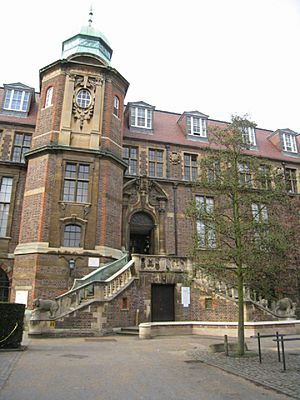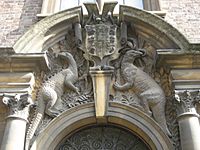Sedgwick Museum of Earth Sciences facts for kids
 |
|
| Established | 1912 |
|---|---|
| Location | Downing Street, Cambridge, England, United Kingdom CB2 3EQ |
| Type | Science museum |
| Collection size | 1.5 million specimens |
| Visitors | 168,021 (2019) |
| University of Cambridge Museums | |
The Sedgwick Museum of Earth Sciences is a cool place to learn about geology! It's the geology museum for the University of Cambridge in England. You can find it on Downing Street in central Cambridge. This museum is the oldest of the eight museums that are part of the University of Cambridge Museums. It's a fantastic spot to explore rocks, minerals, and fossils.
Museum History
How the Museum Started
The museum's story began with Dr. John Woodward. He spent over 35 years collecting and organizing almost 10,000 specimens. These were kept in five special walnut cabinets. Dr. Woodward left two of these cabinets to the university when he died. The university later bought two more, and the fifth was added in the 1840s. These original cabinets are still used in the museum today! Dr. Woodward also left money to create a special job: the Woodwardian Professor of Geology.
Growing the Collection
Adam Sedgwick took over the job of expanding the collection. He bought several ichthyosaur skeletons from a famous fossil hunter named Mary Anning. The collection grew so much that it needed more space. Sedgwick convinced the university to set aside room in the Cockerill Building. But even that wasn't enough! By the time he passed away, the collection was huge. So, everyone decided to build a new museum just for it, in his memory.
Building the Sedgwick Museum
The construction of the Sedgwick Museum was led by Thomas McKenny Hughes. He was very good at getting things done. He convinced the university to build the museum and raised over £95,000 from public donations. That's a lot of money! The museum officially opened its doors on March 1, 1904. King Edward VII even attended the opening ceremony.
Amazing Collections
The Sedgwick Museum has about 2 million rocks, minerals, and fossils. These specimens cover an incredible 4.5 billion years of Earth's history. They are super important for scientists to study and for people to learn from. You can find some information about the collections on the museum's website.
Mineral Collection Highlights
The Mineral Collections hold between 40,000 and 55,000 mineral specimens. These come from all over the world. There are also more than 400 pieces of meteorites! Many rock samples come with a thin slice that scientists can look at under a microscope. The collection is especially strong in minerals from Cornwall and the Lake District in England. It also has specimens from the Binntal in Switzerland. You can see some of these amazing minerals in the museum's Mineral Gallery.
Charles Darwin's 'Beagle' Collection
The 'Beagle' Collection is very special. It includes about 2,000 rocks and a few fossils. These were collected by the famous scientist Charles Darwin. He gathered them during his journey around the world on the ship HMS Beagle between 1831 and 1836.
Other Important Collections
- Harker Collection: This collection has many igneous and metamorphic rocks. It's named after Alfred Harker, a leading rock expert who spent years organizing it.
- Maurice Black Sedimentary Petrology Collection: This collection has about 32,000 rock samples and thin slices of sedimentary rocks.
- Sedgwick Museum Archive Collection: This part keeps important papers about the museum's history. It also includes notes and drawings from Adam Sedgwick himself. It even has information about the Sedgwick Club, the oldest student geology group in the world!
Palaeontological Collection
The Palaeontological Collection is huge, with over 1 million fossils from all over the globe. These fossils help us understand ancient life on Earth.
A. G. Brighton Building
The A. G. Brighton Building is a special place built to store and care for geological collections. It's named after Albert George Brighton, who was the museum's curator for many years.
Special Exhibitions
In 2009, the museum put on a big exhibition called Darwin the Geologist. This was part of the celebrations for Charles Darwin's 200th birthday. The exhibition showed Darwin's early work in geology. It displayed many of the specimens he collected during his Beagle voyage. A new sculpture of a young Darwin was also shown for the first time. The sculptor Anthony Smith created it, and Darwin historian Janet Browne unveiled it.
Visiting the Museum

It's free to visit the Sedgwick Museum! The museum is open from 10 AM to 5 PM on weekdays. On Saturdays, it's open from 10 AM to 4 PM. It's sometimes open on Bank Holidays but closed on Sundays. The Sedgwick Museum is a great place to learn more about Earth Sciences. It often takes part in big Cambridge events like the Cambridge Science Festival. The museum also offers fun activities for families and temporary exhibitions.
The museum's logo features an Iguanodon skeleton. You can see this skeleton near the entrance. A sign explains that the skeleton is standing upright, which isn't how the real dinosaur would have stood. But because this upright pose is so well-known and used in the logo, they decided to keep it that way!
See also
 In Spanish: Museo Sedgwick de Ciencias de la Tierra para niños
In Spanish: Museo Sedgwick de Ciencias de la Tierra para niños




